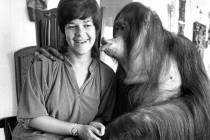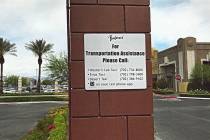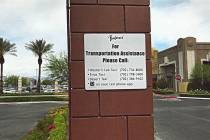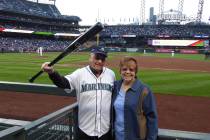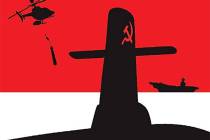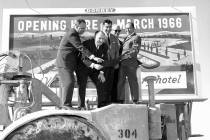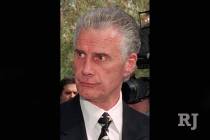Why didn’t judge recuse himself in the long ago trial of Jose Ecchavarria?

The man who killed Las Vegas FBI agent John Bailey may get a new trial more than 25 years after the fact. But not because he didn’t do it.
The evidence is clear that Jose Echavarria shot the agent three times during an attempted bank robbery on June 25, 1990. The 29-year-old dealer was disguised as a woman and dropped his wallet as he fled. Agents went to the apartment just six blocks away and found the disguise. His fingerprints were on two $100 bills dropped inside the bank. The evidence against him was overwhelming.
His roommate and getaway driver, Carlos Gurry, a 27-year-old laundry worker, was also arrested and convicted of charges, but not murder. He waited outside the bank and didn’t fire a weapon. Echavarria fled to Mexico, where he was arrested and returned to Las Vegas.
If ever there was an open-and-shut case, this was it. Echavarria received the death penalty. Gurry received life with the possibility of parole.
In death penalty cases, extensive appeals are routine, so Echavarria’s attorneys filed appeal after appeal on various legal issues. The Nevada Supreme Court denied them all, and in an appeal to the federal court, U.S. District Judge Miranda Du kicked all but one issue.
In January, Du issued a 57-page opinion concluding Echavarria had one valid point. He deserved a new trial because of the appearance of judicial bias. The judge who tried the case, District Judge Jack Lehman, should have told Echavarria and his attorneys that in 1986 and 1987, Lehman, then the chairman of the Colorado River Commission, had been investigated by the FBI on suspicion of serious fraud allegations involving land transactions. Lehman wasn’t charged, but he was investigated.
Echavarria claimed his constitutional rights to a fair trial were violated because Lehman had been biased. Du said that there was no proof of bias, but that it should have been disclosed by the judge so Echavarria could have asked for a new judge. “It was constitutionally intolerable for the trial judge to preside over the case,” Du wrote.
Here’s the ironic twist. Lehman did disclose it. Just not to Echavarria and his attorneys.
On Sept. 17, 1990, Lehman told Gurry’s defense attorney, David Wall, and prosecutor Bill Henry. No one objected to Lehman remaining on the case. The next month, there was a meeting between FBI officials and Clark County prosecutors to discuss it. A prosecutor said he would suggest a chambers meeting with all the parties to discuss the potential conflict.
But Echavarria’s attorneys Michael Stuhff and David Schieck said they were never told of the investigation or they would have asked for a new judge.
The U.S. 9th Circuit Court of Appeals will have to decide whether to uphold or reject Du’s ruling, and in all likelihood, it could end up before the U.S. Supreme Court.
Should Lehman have voluntarily recused himself from the case against shooter Echavarria and getaway driver Gurry?
In retrospect, absolutely.
Someone actually told Lehman’s wife he shouldn’t be hearing the case, which went to trial in 1991.
A new trial brings plenty of problems. After 25 years, witnesses are dead. Others are going to have trouble remembering. There’s a chance the man who murdered Bailey might walk.
I knew John Bailey. He was a funny, likable professional who in 21 years with the FBI, 13 in Las Vegas, worked on many cases I covered as the Review-Journal’s federal court reporter. I didn’t know his wife, Beth, or his two teenage daughters, 15 and 14 at the time of his death, but I considered him a friend.
When they named the Las Vegas FBI building after him following his murder, I was glad. Just now, pouring over old newspaper clips, the Las Vegas Sun’s color photo of him on a gurney being rushed to the hospital where he died made me tear up.
He was involved in high-profile cases, including the tax evasion case against federal Judge Harry Claiborne, the 1978 unsolved kidnapping case of 6-year-old Cary Sayegh, the 1978 case in which two men tried to bribe then Gaming Commission Chairman Harry Reid, the 1979 torching of the Chicken Ranch brothel, and the 1984 bank robbery in which he recovered $1 million of the $2.5 million stolen.
Bailey, 47, was in the wrong place and the wrong time. He was serving a subpoena for records for someone being investigated when Echavarria entered the bank in his clownish disguise and pulled a gun on a teller, who screamed and jumped back. The would-be bank robber changed his plan and tried to leave.
Bailey was a Vietnam veteran with two Bronze Stars and a marathon runner weighing about 155 pounds and standing 5 feet 9 inches tall. He tried to stop Echavarria. He identified himself as FBI and ordered him to halt. When Echavarria kept walking, Bailey fired a shot shattering the bank’s front door.
Du’s order described it this way: “Echavarria stopped. Bailey grabbed the gunman, held him against the wall, and ordered him to drop his gun, which Echavarria eventually did.”
Bailey asked someone to call the FBI and asked a bank employee to get his handcuffs from his car, seating Echavarria in a chair. When the handcuffs arrived, Du wrote, Echavarria jumped out of the chair and collided with Bailey. During the scuffle, Bailey fell and the gunman retrieved his own .38 revolver and shot the agent. Three times. In the right arm, the lower left chest and the fatal shot to the upper right chest.
Why didn’t Lehman realize there would be at least an appearance of bias on his part? We’ll never know. He’s in no condition to discuss it. He’s in fragile health and moved to California.
If his investigation by the FBI created an appearance of bias, why didn’t Henry or Wall, who later became a judge himself, see that as a problem? After all, he could have been biased in either direction, either for or against the FBI. He could have wanted to seek the FBI’s favor or he could have resented that investigation. The fact that neither the prosecutor or Gurry’s defense attorney saw it as a problem speaks volumes.
Du’s opinion has outraged the FBI, and Attorney General Adam Laxalt decided his office will appeal her ruling. The case is in the hands of defense attorney Michael Pescetta, a expert in death penalty cases, and Deputy Attorney General Jeffrey Conner.
The first trial lasted four weeks and is chronicled in the 2014 book by retired agent Gary Magnesen.
“FBI Agent Down” focuses on Bailey’s life and death, the investigation into his murder and the backgrounds of Echavarria and Gurry, both refugees from Castro’s Cuba, as well as the trial itself.
Now he’ll have to add an addendum, especially if Echavarria goes free.
If Echavarria walks, a tragic story becomes a horror story.
Jane Ann Morrison’s column appears Thursdays. Email her at jmorrison@reviewjournal.com or leave a message at 702-383-0275. Find her on Twitter @janeannmorrison



